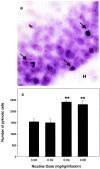Nicotine self-administration impairs hippocampal plasticity
- PMID: 11978841
- PMCID: PMC6758344
- DOI: 10.1523/JNEUROSCI.22-09-03656.2002
Nicotine self-administration impairs hippocampal plasticity
Abstract
Nicotine, the neuroactive compound responsible for tobacco addiction, is primarily believed to have beneficial effects on the adult brain. However, in heavy smokers, abstinence from nicotine is accompanied by cognitive impairments that suggest adverse effects of nicotine on brain plasticity. For this reason, we studied changes in plasticity-related processes in the dentate gyrus (DG) of the hippocampal formation of animals trained to self-administer nicotine. The DG was chosen because it undergoes profound plastic rearrangements, many of which have been related to memory and learning performances. In this region, we examined the expression of the polysialylated (PSA) forms of neural cell adhesion molecule (NCAM), PSA-NCAM, neurogenesis, and cell death by measuring the number of pyknotic cells. It was found that nicotine self-administration profoundly decreased, in a dose-dependent manner, the expression of PSA-NCAM in the DG; a significant effect was observed at all the doses tested (0.02, 0.04, and 0.08 mg/kg per infusion). Neurogenesis was also decreased in the DG, but a significant effect was observed only for the two highest doses of nicotine. Finally, the same doses that decreased neurogenesis also increased cell death. These results raise an important additional concern for the health consequences of nicotine abuse and open new insight on the possible neural mechanisms of tobacco addiction.
Figures




References
-
- Altman J. Are new neurons formed in the brain of adult mammals? Science. 1962;135:1127–1128. - PubMed
-
- Arneric SP, Sullivan JP, Decker MW, Brioni JD, Bannon AW, Briggs CA, Donnelly-Roberts D, Radek RJ, Marsh KC, Kyncl J, Williams M, Buccafusco JJ. Alzheimer's disease and associative disorders, Vol 9. Lippincott-Raven; Philadelphia: 1995. Potential treatment of Alzheimer's disease using cholinergic channel activators (ChCAs) with cognitive enhancement, anxiolytic-like and cytoprotective properties. pp. 50–61. - PubMed
-
- Becker CG, Artola A, Gerardy-Schahn R, Becker T, Welzl H, Schachner M. The polysialic acid modification of the neural cell adhesion molecule is involved in spatial learning and hippocampal long-term potentiation. J Neurosci Res. 1996;45:143–152. - PubMed
-
- Carlen PL, Wilkinson A. Reversibility of alcohol-related brain damage: clinical and experimental observations. Acta Med Scand [Suppl] 1987;717:19–26. - PubMed
Publication types
MeSH terms
Substances
LinkOut - more resources
Full Text Sources
Research Materials
Miscellaneous
